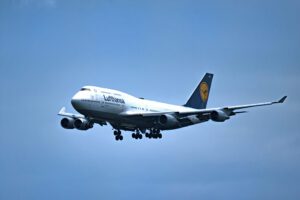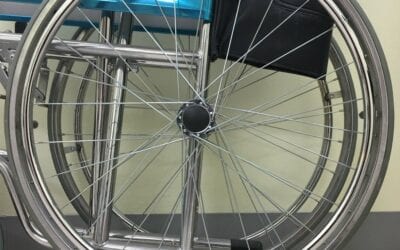Apple AirTags can be used in checked and carry-on luggage by the FAA and TSA. AirTags help air travelers locate their luggage when the airlines lose or misplace it.

Lufthansa, Boeing 747 landing at Washington Dulles International Airport, Copyright © 2022 NSL Photography, All Rights Reserved.
In 2001, I took my first Mediterranean cruise. To get to the start of the voyage in Spain, my cruise line routed me from my home airport in Philadelphia to Atlanta and Barcelona. Thunderstorms regularly ravaged much of the country that summer, and it caused my plane for my flight to Atlanta to arrive two hours late in Philadelphia. Our plane to Barcelona left as our plane to Atlanta arrived. Apple AirTags could have saved the day.
As we got off the plane in Atlanta, a cruise line representative met us and the other dozen passengers on our flight who were also taking the cruise. Within ten minutes, we boarded an Air France 747 to Paris. Almost immediately upon sitting down, the plane left the gate. I leaned over to my wife and said that there was no way our checked luggage was on the plane. As expected, our luggage was nowhere to be found after we landed on our Paris to Barcelona flight. Back in 2001 Apple Air Tags didn’t exist, but they would have been very useful.
Along with the others from Philadelphia, we filed a baggage claim. We let the cruise line know our bags were missing, then left for the hotel. At the hotel, the cruise line rep told us that Delta said the luggage was in Paris. We knew that wasn’t true, but Delta wasn’t listening.
Apple AirTags can provide proof of the location of air travelers’ bags.
If only Apple had invented the iPhone and Apple AirTags in 2001, we could have shown them that our bags were in Atlanta.
Two days later, the cruise line finally insisted that Delta look for the more than twenty pieces of missing luggage at Atlanta Hartsfield Airport. The cruise rep told Delta she wouldn’t hang up until they looked for our bags. Forced to check in Atlanta, Delta was back on the phone within five minutes, confirming our bags were found. They were delivered to our hotel the following afternoon. We were on the ship the following day with our bags.
Waiting for Delta to come to their senses, I silently screamed the Howard Beale mantra, “I’m as mad as hell, and I’m not going to take this anymore! An Apple AirTag could have allowed me to prove to Delta that the bags were in Atlanta days before they finally agree that they were there.
Airlines are struggling to handle passengers’ luggage. This summer, they mishandled bags twice as often as last year.
Airlines have struggled globally to deliver passenger luggage this year. For example, in April, US airlines alone “mishandled” almost 220,000 bags. That’s more than double the number in 2021. In July, Delta Airlines was forced to send a plane to London’s Heathrow Airport to repatriate 1,000 lost bags to the US. The bags filled the cargo bay and the passenger cabin, leaving no room for any passengers on the flight.
I recommended using Apple AirTags in my Travelers United column this past summer, How to prevent delayed or lost luggage or recover it if the worst happens. There are many ways air travelers can try to prevent their checked luggage from being delayed or lost, but they don’t always work.
Electronic tracking devices can rescue air travelers desperate to retrieve their bags for their business and leisure journeys.
That’s why electronic tracking devices like Apple AirTags are important. They can rescue air travelers by locating luggage virtually anywhere. The airline changed the luggage carousel location at my destination airport not long ago, but my bag wasn’t there. Using my iPhone, I located my AirTagged bag. It was set aside near the new carousel location.
Apple AirTags use a U1 ultra-wideband chip to send a low-power, secure Bluetooth signal. It can be detected by nearby Apple devices. The location is sent to the “Find My” network on Apple’s iCloud. When the AirTag owner logs into the “Find My” network, it will display their bag’s location with the AirTag in it on their “Find My” app map.
It’s been documented that Apple AirTags can locate passenger luggage even when the airlines mishandle them.
Recently, numerous air travelers using Apple AirTags to find their missing luggage have been in the news. Frédéric Harper flew with Air Canada from Montreal to Dublin only to see that his AirTagged bag was still in Canada. A British Airways passenger complained that while the airline said they tried to deliver her luggage to her in the UK, her iPhone showed it was still in Florida. A maid of honor’s luggage was never displayed on the carousel after flying home from a destination wedding in Portugal. She had an Apple AirTag in the bag. It was located at the airport, where it was buried among other bags. Unfortunately, she had gate-checked her carry-on, which contained no Apple AirTag. It was still missing when she recovered her checked bag.
Lufthansa states that reports of them banning Apple AirTags aren’t accurate.
This past week there was a surprising report that Lufthansa had banned the use of AirTags in checked luggage. I reached out to Lufthansa’s Tal Muscal, Head of Corporate Communications for the Americas, who told me the report wasn’t accurate. Mr. Muscal said,
“Lufthansa has not banned AirTags. There are incorrect reports circulating in Germany and the U.S.”
Why would airlines even consider banning AirTags or other electronic luggage-tracking products?
The only issue I can think of that would cause an airline to ban the use of Apple AirTags and other electronic tracking devices from checked luggage would be safety, so let’s look at AirTag safety.
Batteries that power Apple AirTags don’t disqualify them from being inserted in checked or carry-on luggage.
Apple AirTags are powered by single-use CR2032 “lithium coin” batteries. According to the US Federal Aviation Administration (FAA), these batteries, installed in electronic devices, are permitted in both carry-on and checked/gate-checked luggage on scheduled commercial airplanes. I know of no international aviation regulatory body that doesn’t permit CR2032 batteries installed in working electronics stowed in checked baggage.
On October 27, 2017, an FAA Advisory Circular stated they permit low-powered wireless communications, such as Bluetooth. Apple AirTags are electronic devices that use an ultra-wideband, low-power Bluetooth transmitter.
According to the FAA, “experience shows that low-power emission levels do not affect aircraft systems.”
Apple AirTags don’t use WiFi or cellular services. They use Bluetooth, which is permitted while planes are aloft.
AirTags don’t use WiFi or cellular services. Therefore, it makes no sense to consider them in the same electronic communication device class, including cellphones, laptops, cellular routers, and tablets.
TSA says Apple Airtags are allowed to be used in checked luggage.
The question, “Am I allowed to put an AirTag inside my checked-in bag,” was asked on the Transportation Security Administration (TSA) “AskTSA” Twitter feed. TSA answered, “Smart trackers are allowed in checked bags.”
It’s clear that smart trackers in checked and carry-on luggage help air travelers locate their bags accurately. AirTags conform to FAA and TSA regulations for use in checked and carry-on luggage. I recommend that air travelers use Apple AirTags in all their bags to locate them in case they’re lost, stolen, or delayed. AirTags can help passengers and their airline and/or police recover their baggage.
READ ALSO:
How to file airline complaints and get compensation
Why female crash dummies have no place in safety testing today
After many years working in corporate America as a chemical engineer, executive and eventually CFO of a multinational manufacturer, Ned founded a tech consulting company and later restarted NSL Photography, his photography business. Before entering the corporate world, Ned worked as a Public Health Engineer for the Philadelphia Department of Public Health. As a well known corporate, travel and wildlife photographer, Ned travels the world writing about travel and photography, as well as running photography workshops, seminars and photowalks. Visit Ned’s Photography Blog and Galleries.



